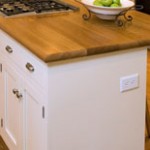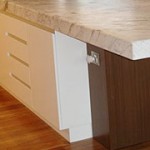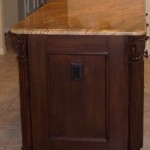Cutting a Cabinet for an Electrical Outlet
Cutting a kitchen or bathroom cabinet to receive an electrical box should be done accurately. In order for the outlet cover to fit over the cutout properly, you should thoroughly check your layout prior to making the cuts. These tips will apply to sink cabinet electrical cutouts, microwave outlet boxes, decorative end panels, computer cupboards, office storage or anywhere that power needs to be installed in your cupboards.
Tools and Materials Needed:
- Electric Drill
- 1/8” and 3/8” Drill Bit
- Skill Saw and/or Jig Saw
- Tape Measure
- Masking Tape
- Outlet Box
- Pencil
- Throw Away Board
Important Tips:
- Always allow for face-fame overhangs when measuring
- Make cuts from the unfinished side of the cupboard
- Triple check all of your measurements
- Be sure to cut out for the outlet plate attachment screws
Research Your Area’s Building Code
Island cupboards generally require an outlet to be installed in compliance with county or city building codes. The same usually applies to peninsula cabinetry. In our area you must have one outlet installed for every seven feet of countertop. It would be wise to check with an area contractor to see how many you will need to install, given your situation.
Space Saver Microwave Cabinets
Do not cut anything for the outlet until you have installed the upper cabinet either to the left or right of where the hood box goes. This way you can get accurate measurements.
Not all electrical outlets in hood cabinets will need to be cut in the back of the cupboard. If the electrician has wired an outlet in the proper place in the wall, cut it out. Most cabinet installers prefer that a wire be stubbed out of the wall and brought into microwave cabinet through a one-to-two inch hole. Then, the electrician mounts an external outlet box to the back of the cupboard.
The method below will work on these cabinet types:
Sink Cabinets
Microwave Hood
Finished-Back Island Cabinets Without Decorative Door Panels
Finished Ends of Base, Wall or Pantry Cupboards
Formica Kitchen Cabinets
Real wood-Cherry, Maple, or Oak
Thermofoil
Vinyl
How To Add an Electrical Outlet to Cabinet
When I learned how to add a cut out for an electrical outlet, I triple checked the lines I had drawn on the cabinet before doing anything. It was a very expensive pantry cupboard. One mistake and I would have lost a lot of money.
- Take the doors off of the cabinet
- Place the cupboard in proper position to mark it and cut
- If you are cutting with the finished side up use masking tape over your marks
- Measure and precisely draw your electrical box cutout lines
- Double check the lines you have laid out
- Triple check what you have measured and drawn
- STOP! Access the situation again making sure that your cuts will be correct
- Drill holes in all four corners using the eight inch thick drill bit. This is only a pilot hole for the three eights inch thick drill bit that will follow. When drilling the pilot hole, your aim is for the three eights hole to fall on the inside of the ninety degree corner lines.
- Insert your jig saw in one of the holes and start cutting, keeping the saber saw nice and flat to your work. This is no time to be in a hurry.
- Before finalizing the last cut, place a piece of masking tap across the piece you are cutting out so that it does not just drop. This will help to not tear-out any good material.
Important: When drilling your holes, DO NOT BLOW-OUT the finished side of the cabinet. Use your head and drill the holes correctly.
Cutting for an Electrical Box in a Finished Cabinet Door End Panel
Oftentimes on island or peninsula cupboards there will be false door panels. In such cases the cabinet and the panel will need to be cut out for the outlet box. You should mark and cut the decorative door first and then mark the cupboard using the outlet cutout in the door as a template. ALWAYS, cut from the backside! When drilling the eight inch (1/8”) pilot holes, place the door face down on your throw away board and drill. Then, turn the door over and drill the three eights inch wide holes, pushing the drill from the finished side toward the backside.
In my experience, I’ve discovered that the safest way to cut for power outlets is to use a jig (or, “saber saw”). It takes a little longer than using a skill saw, but is much safer.
I generally cut out for outlets that get installed on the inside of cupboards with a skill saw. You will find garbage disposal power supplies and hood cabinet outlets that will be behind the doors and rarely ever seen. If you make a slight error while fitting for them it will not really be noticeable.
Finally, the best thing you can do is triple check your measurements and then reexamine what you are doing before making any cuts at all for electrical boxes getting installed in your kitchen, computer, office or bathroom vanity cabinets. If you make a mistake it can be very costly. So, don’t make a mistake and your power supply outlet and cover will have the appearance of a professional installation.



